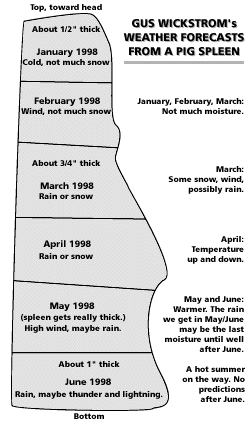Here’s a quirky one. Have you ever heard of a pig spleen being able to predict the weather? You can call it folklore—but what do you call it when it works?
This article first ran in the 1999 edition of The Old Farmer’s Almanac and was one of the most popular—and controversial—ever published. Gus Wickstrom died in 2007.
Legendary forecaster Gus Wickstrom of Tompkins, Saskatchewan
Step into Gus Wickstrom’s office in Tompkins, Saskatchewan. Gus, a man of Swedish descent who’s lived in this prairie province all of his 60-plus years, is a weather forecaster. He can predict upcoming conditions for the next six months, yet his technology requires no fancy equipment, no high-tech razzle-dazzle. All Gus needs is a barn and a farmhand or two standing by … because he predicts the weather by looking at a pig spleen.
Every 6 months or so, Gus slaughtered a pig, and in the frugal way of farm families, he found a way to use everything but the squeal, as they say. Gus closely scrutinized the spleen, using a method he learned from his father and Harold Pearson, a neighbor.
Gus divided the spleen into six areas, each representing 1 month. The top of the spleen (closest to the pig’s head) shows the current month. The bottom indicates the end of the upcoming 6-month period. Where the spleen thickens, a change in the weather is indicated, usually pointing to a cold spell. Where there’s a pronounced bulge, expect even more inclement weather. Gus could even read wind and rain into the variations in the spleen.

Meet 72-year-old Joe King, in Wynyard, Saskatchewan
Joe also learned pig-spleen weather predicting from his father. But Joe is adamant that the pig must be slaughtered in the fall or early winter; a spring spleen, says Joe, is not nearly as accurate. His method predicts only temperature, not precipitation. In the fall of 1997, Joe slaughtered his pig and pulled out a spleen that was even all the way through. This, he says, was one of the first indications that Saskatchewan would experience an even-tempered winter. Never mind that meteorologists were hysterical about the phenomenon called El Niño; or that onion skins and corn husks were thick. Joe predicted a mild winter with just a few cold days, and his temperature predictions were right on the money.
I checked with a few animal scientists, whose reactions were of disbelief. After all, said the experts, a spleen is a vascular, ductless organ that stores blood, destroys worn-out red blood cells, forms lymphocytes, and so on. “A spleen,” I was reminded, “is a useful organ that has bodily functions. It has nothing to do with predicting the weather.”
I found myself defending this form of weather prophesying, even though I know it’s folklore. I, too, have farming in my blood, so I went to the one person I knew would have the answer—my father. “I recall,” Dad said, going back to his upbringing on a farm near Goodeve, Saskatchewan, “that our Polish neighbors also looked at the spleen of a pig to forecast the weather. And I know it’s something the Ukrainian families did as well.”
Aha, I thought to myself. It’s not just Gus and Joe—it’s in many cultures, probably more than I’ll ever know. Those who believe in pig spleen weather prognosticating have seen it work, and that’s just the way it is.
See other ways to predict the weather, from cutting open a persimmon fruit to reading the stripes of a woolly worm caterpillar!
Of course, you can always rely on The Old Farmer’s Almanac weather predictions—traditionally 80% accurate! Pick up a copy of the latest Almanac today!










